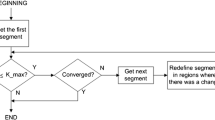Abstract
The Kohonen self-organizing algorithm is a powerful tool to achieve a categorization of vectorial stochastic data into classes. Many researchers use it to get a preliminary reduction of the data complexity in numerous application fields. They address some problems which are usually solved by means of statistical methods like Classification, or Principal Component Analysis. In this paper, we propose to extend this approach to another data analysis method: the simultaneous analysis of two qualitative variables which are crossed in a contingency table.
Preview
Unable to display preview. Download preview PDF.
Similar content being viewed by others
References
BENZECRI J.P.: L'analyse des Données, T. 2, L'Analyse des Correspondances, Dunod, Paris, 1973
BLAYO F., DEMARTINES P.: Data analysis: How to compare. Kohonen neural networks to other techniques? In Proceedings of IWANN 91, Prieto od., Lectures Notes in Computer Science, Springer-Verlag, 469–476, 1991
BOUTON C., PAGES G.: Self-Organization and convergence of the one-dimensional Kohonen algorithm with non uniformly distributed stimuli. To appear in Stochastic Processes and their Applications, 1993
COTTRELL M., FORT J.C.: Etude d'un algorithme d'auto-organisalion. Annales de l'Institut Henri Poincaré, Vol. 23, #1, 1–20, 1987
ERWIN E., OBERMAYER K., SCHULTEN K.: Convergence properties of self-organizing maps. In Artificial Neural Networks, Kohonen T. et al eds, Vol. I, North-Holland, 409–414, 1991
HERTZ J., KROGH A., PALMER R.G.: Introduction to the Theory of Neural Computation. Lecture Notes Vol.1, Santa Fe Institute, Addison-Wesley, 1991
KOHONEN T.: Self-Organization and Associative Memory. 3rd Edit. Springer-Verlag, 1989
KOHONEN T.: The Self-Organizing Map. Proc. of the IEEE, Vol. 78, #9, 1464–1480, 1990
LEBART L., MORINEAU A., WARWICK K.M.: Multivariate Descriptive Statistical Analysis: Correspondence Analysis and Related Techniques for Large Matrices. John Wiley, 1984
RITTER H., MARTINETZ T., SCHULTEN K.: Neural Computation and Self-Organizing Maps: An Introduction. Addison-Wesley, Reading, 1992
VARFIS A., VERSINO C.: Clustering of socio-economic data with Kohonen maps. Proc. 3'rd Int. Workshop on Parallel Applications in Statistics and Economics(PASE), Prague, Dec. 1992
Author information
Authors and Affiliations
Editor information
Rights and permissions
Copyright information
© 1993 Springer-Verlag Berlin Heidelberg
About this paper
Cite this paper
Cottrell, M., Letremy, P., Roy, E. (1993). Analysing a contingency table with Kohonen maps: A factorial correspondence analysis. In: Mira, J., Cabestany, J., Prieto, A. (eds) New Trends in Neural Computation. IWANN 1993. Lecture Notes in Computer Science, vol 686. Springer, Berlin, Heidelberg. https://doi.org/10.1007/3-540-56798-4_164
Download citation
DOI: https://doi.org/10.1007/3-540-56798-4_164
Published:
Publisher Name: Springer, Berlin, Heidelberg
Print ISBN: 978-3-540-56798-1
Online ISBN: 978-3-540-47741-9
eBook Packages: Springer Book Archive




